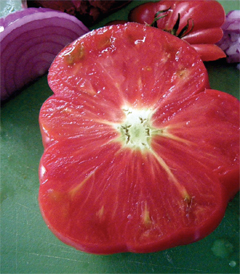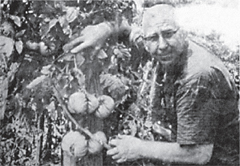
In August my gardener hands are stained nicotine dark from the resinous sap of tangled tomato vines heavy with summer fruit. In the spell of the nightshades I return to my first season of growing tomatoes at Tassajara Zen Mountain Center, deep in the Ventana wilderness of central California. Anchored by a daily meditation schedule of dawn and nighttime zazen, the tomato plants of the Tassajara garden kept my practice grounded by day. Now, almost 35 years later, the intrepid tomato continues to provide long hours of mindfulness and the real wealth of a succulent harvest.
The Solanaceae, or nightshade family, of which the tomato is a charter member, also includes the potato, eggplant, chili pepper, sweet pepper, and tobacco, as well as 90 other genera and close to 2,000 species of related plants. The first wild tomato originated in the arid Andean region of western South America, where the fruit was cultivated for millennia by sophisticated Incan and Aztec farmers. Tomatoes grew in Montezuma’s gardens in 1519, when Cortez first collected the fruit, introducing its ripe seed to Europe. Today, tomato plants colonize the gardening world.
Solanacea may be related to the Latin solamen, which means “relief.” All members of the Solanaceae family contain a Lethean range of powerful sedative alkaloids including morphine, quinine, atropine, nicotine, and strychnine, rendering the nightshades a potent family of dangerous plants. The first European reference to the tomato dates to a 1544 Italian herbal describing the fruit as mala aurea or “golden apple.” The French in turn named the tomato pomme d’amour, or “love apple.” The juicy, dark red, and heart-shaped tomato used by 16th-century herbalists was prized as an aphrodisiac and later feared as a deadly poison, a reputation earned from the tomato’s disreputable relatives: mandrake, henbane, deadly nightshade, jimsonweed, and other species of the Datura genus.
In colonial New England, the tomato was banned by ministers and physicians. Early Pilgrims distrusted the seductive love apple, considering it evil, on a par with dancing, card playing, and theatergoing. The tomato’s contradictory characteristics, as both love potion and nightshade poison, make it all the more appealing. I cannot imagine an edible garden without the invigorating and quieting presence of this Solanaceae member.

M.C. Byles, aka “Radiator Charlie,” bred the
pay off the loan on his house.
This season I planted a delicious heritage tomato, Radiator Charlie’s Mortgage Lifter, well suited for times of economic distress. Recommended by a close farmer friend, this hefty slicer tomato bears a wealth of flat, pleated, one-pound-heavy fruit with deep pink flesh, low in acid and high in flavor. Radiator Charlie was a wrestler and an inventor who lived to be 97 years old. Charlie worked as an auto mechanic in the 1930s. His shop was in Logan, West Virginia, at the base of a steep mountain, where coal trucks rolled down regularly to have their blownout radiators repaired.
Charlie had no formal schooling, yet he could tinker anything back to working order. When he wanted to “build” a better tomato, he planted German Johnson, a huge beefsteak variety, and surrounded it with other large-fruited tomato plants. Charlie collected pollen from the circle of tomatoes with a baby’s ear syringe and squirted that pollen onto the German Johnson plants. He repeated this process patiently for 7 years, season after season, breeding his prize tomato behind the auto shop. Radiator Charlie sold seedlings of this tomato for a dollar apiece, paying off his $6,000 mortgage in 6 years.
Yesterday I spent a morning of mindfulness tying up tomatoes with a dharma friend of 30 years. As she pruned the tomatoes, I made compost with wheelbarrows of their pruned limbs. Radiator Charlie’s Mortgage Lifter is about 3 feet high and coming into fruit. I salivate in anticipation of this love apple, remembering the Zenflavored words of Jeff McCormack, a Southern seed breeder who continues to grow this heritage tomato seed: “What I’m trying to do is save the soul behind these seeds, the thin line that extends from one generation to another… people, culture, and agriculture inextricably intertwined.”